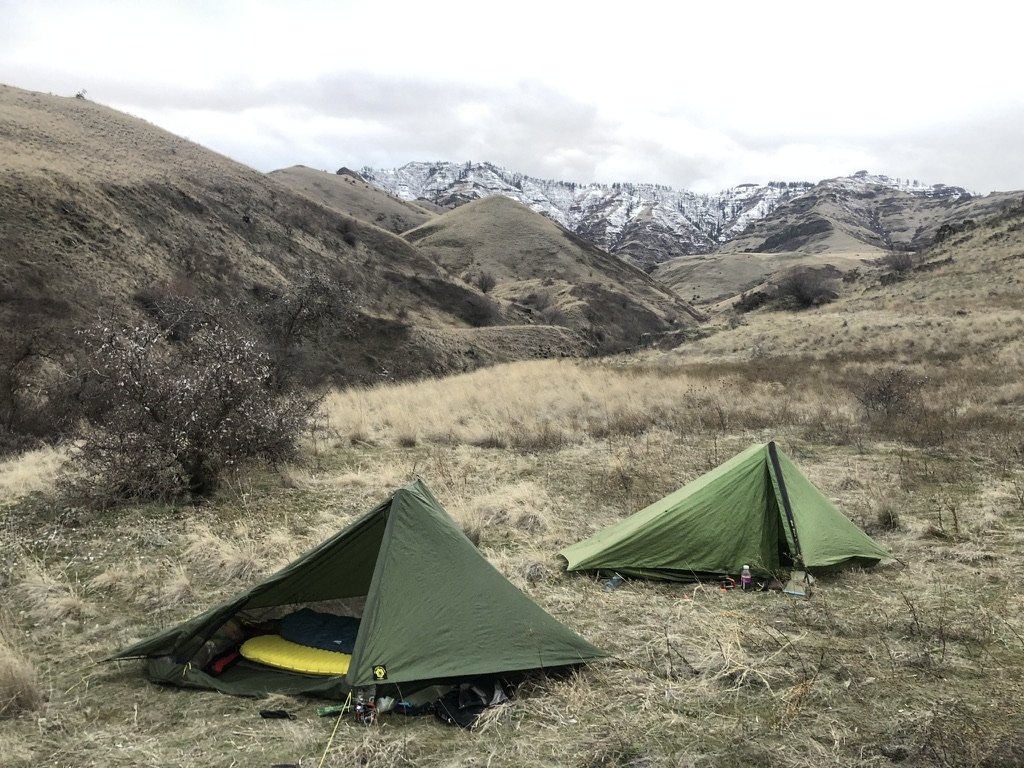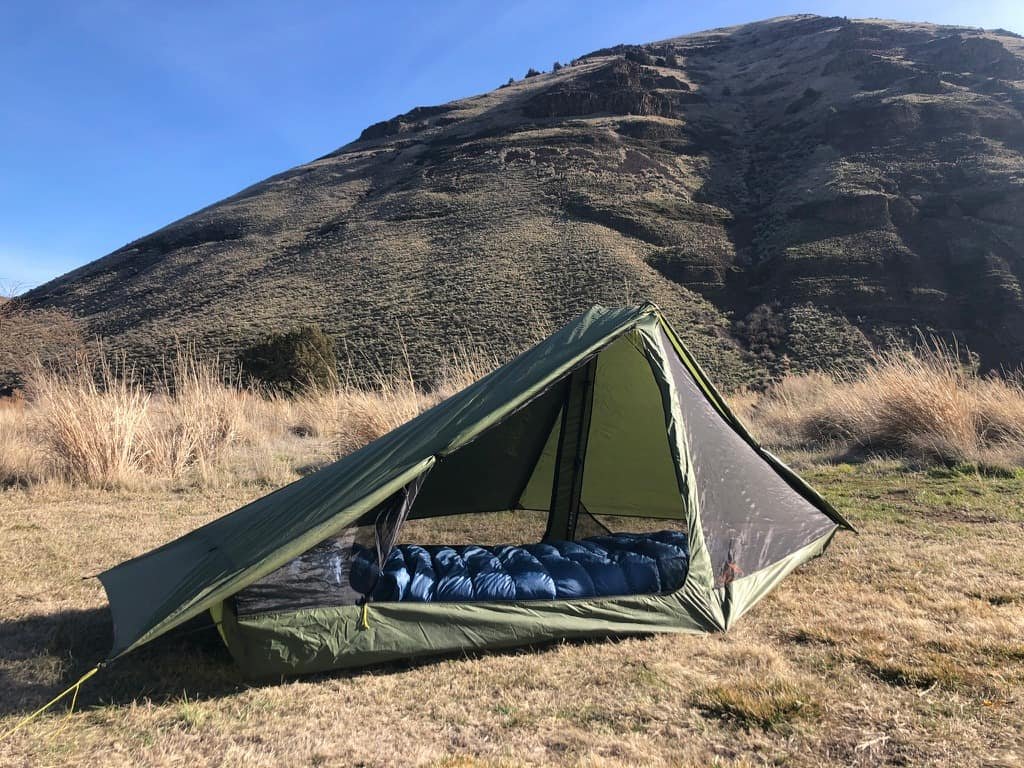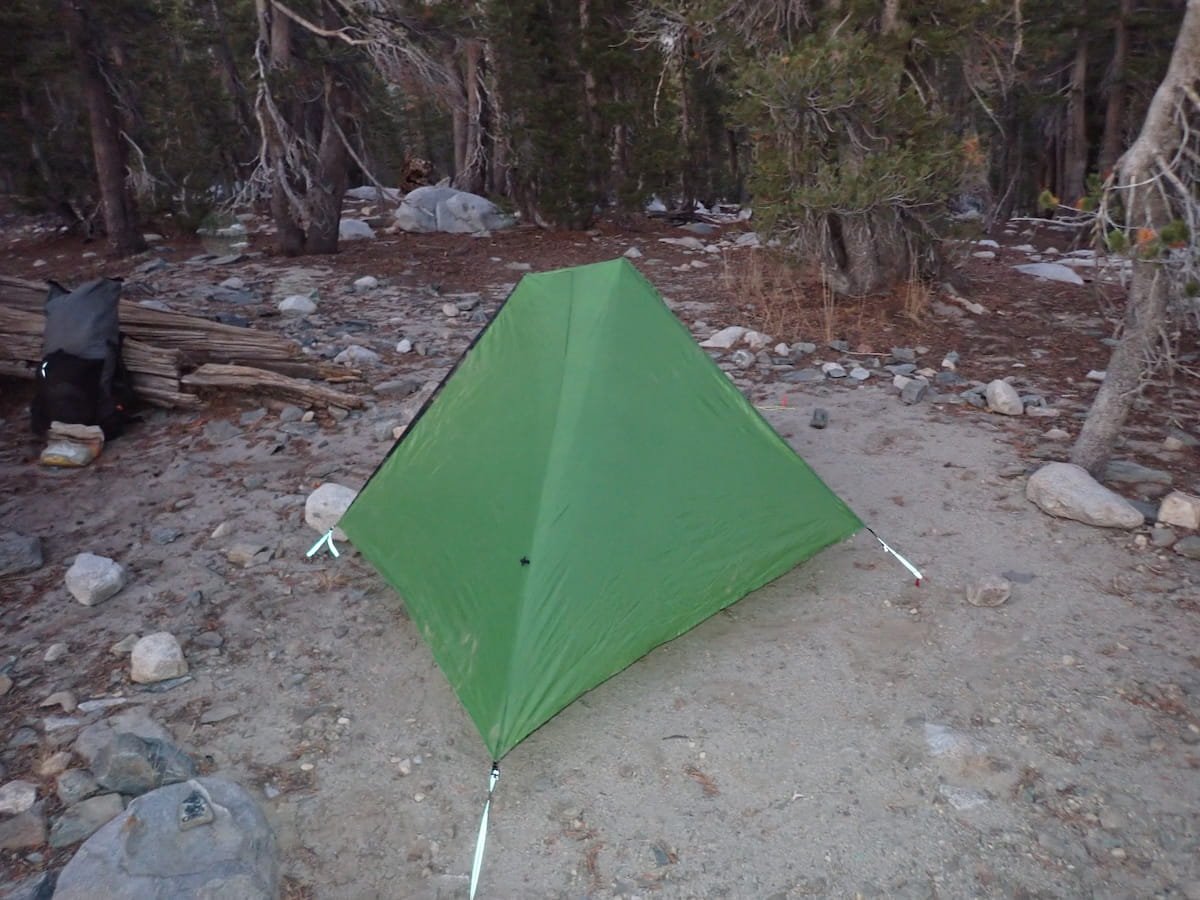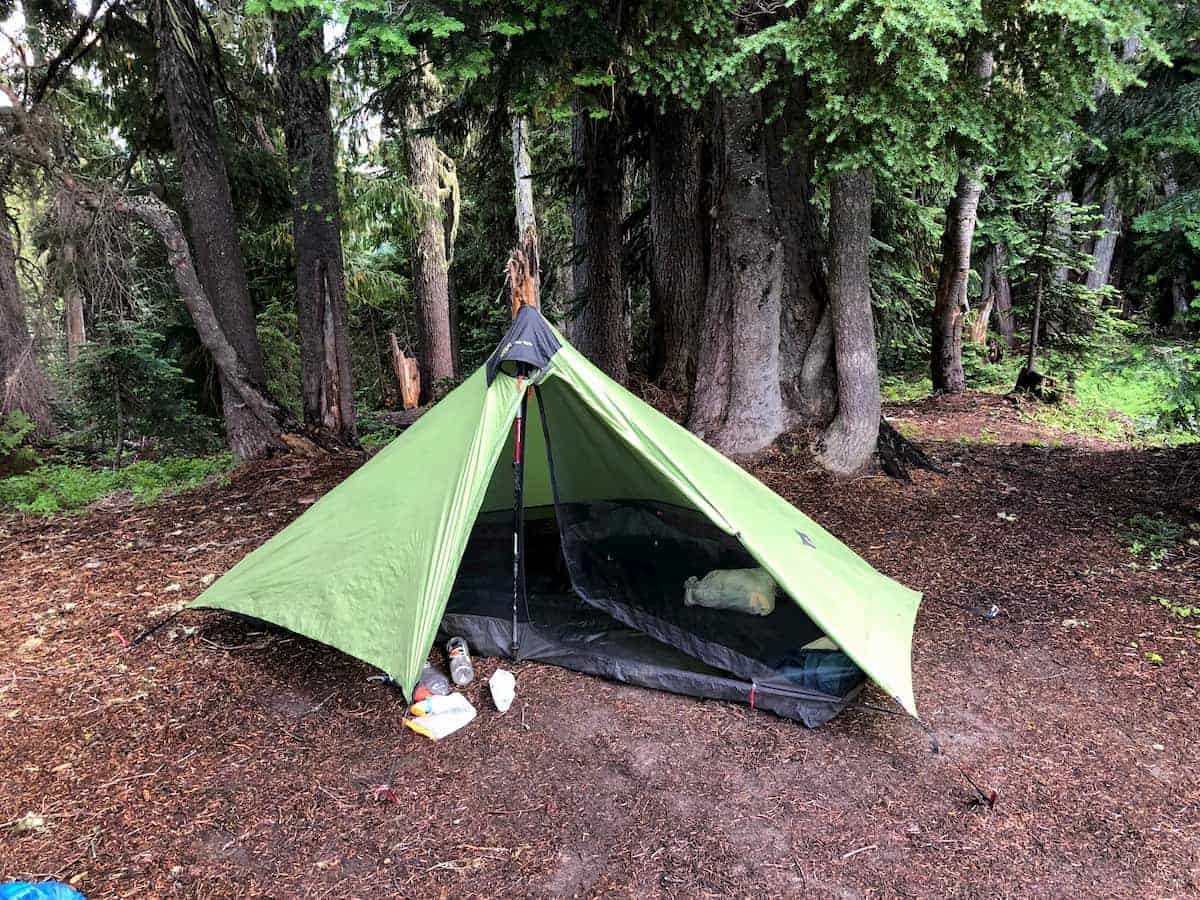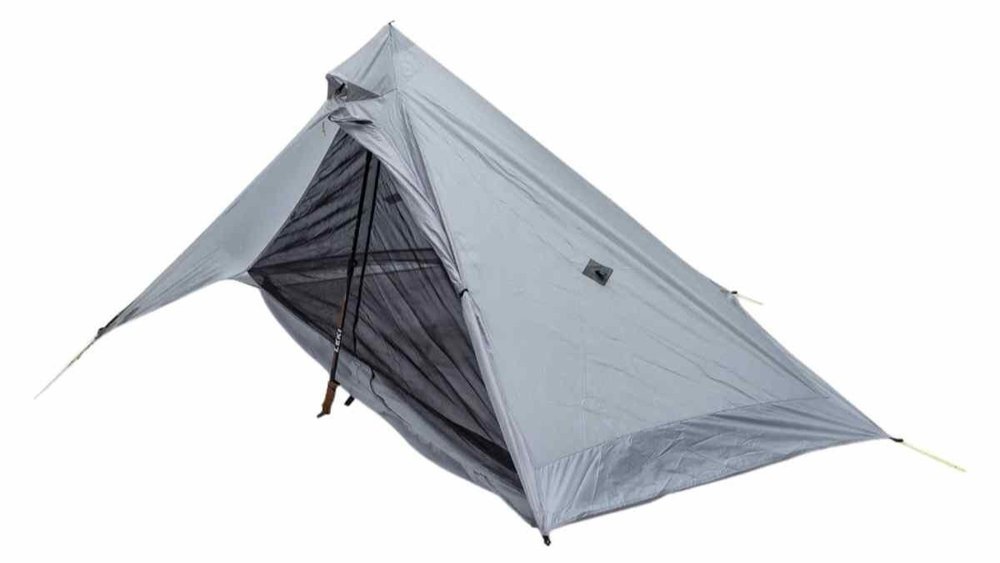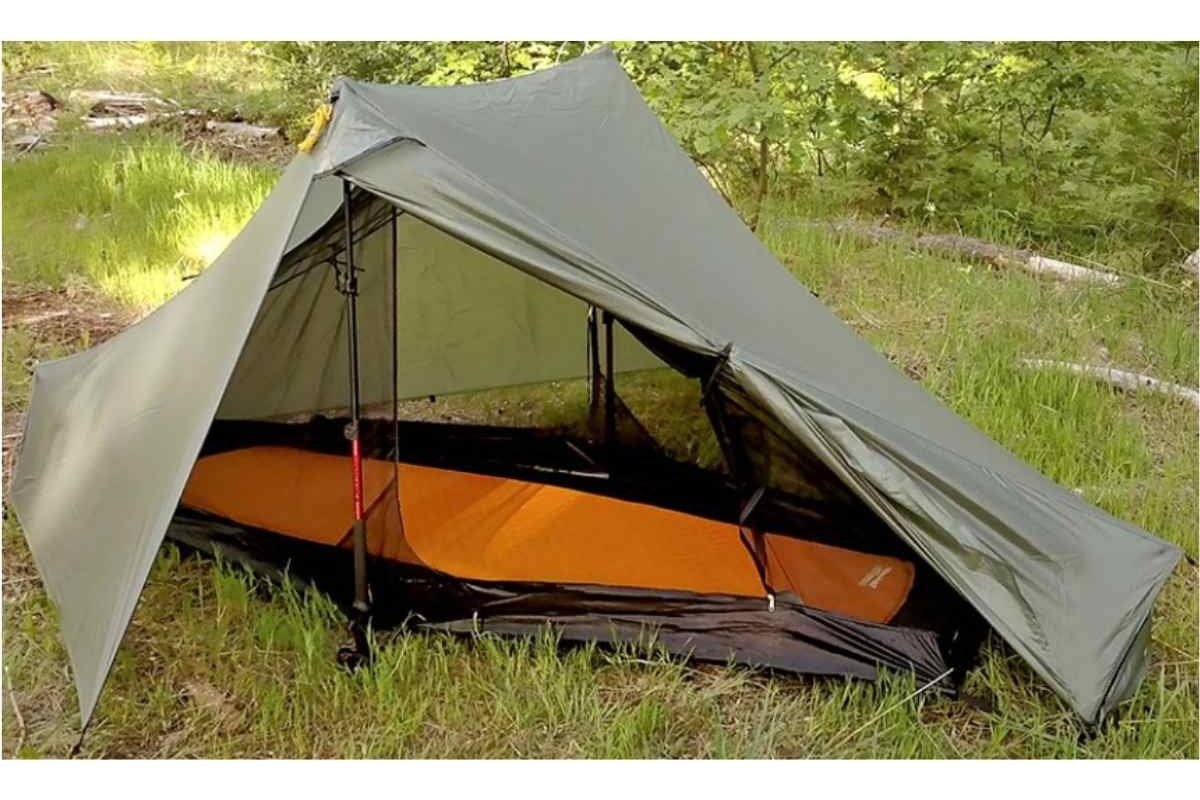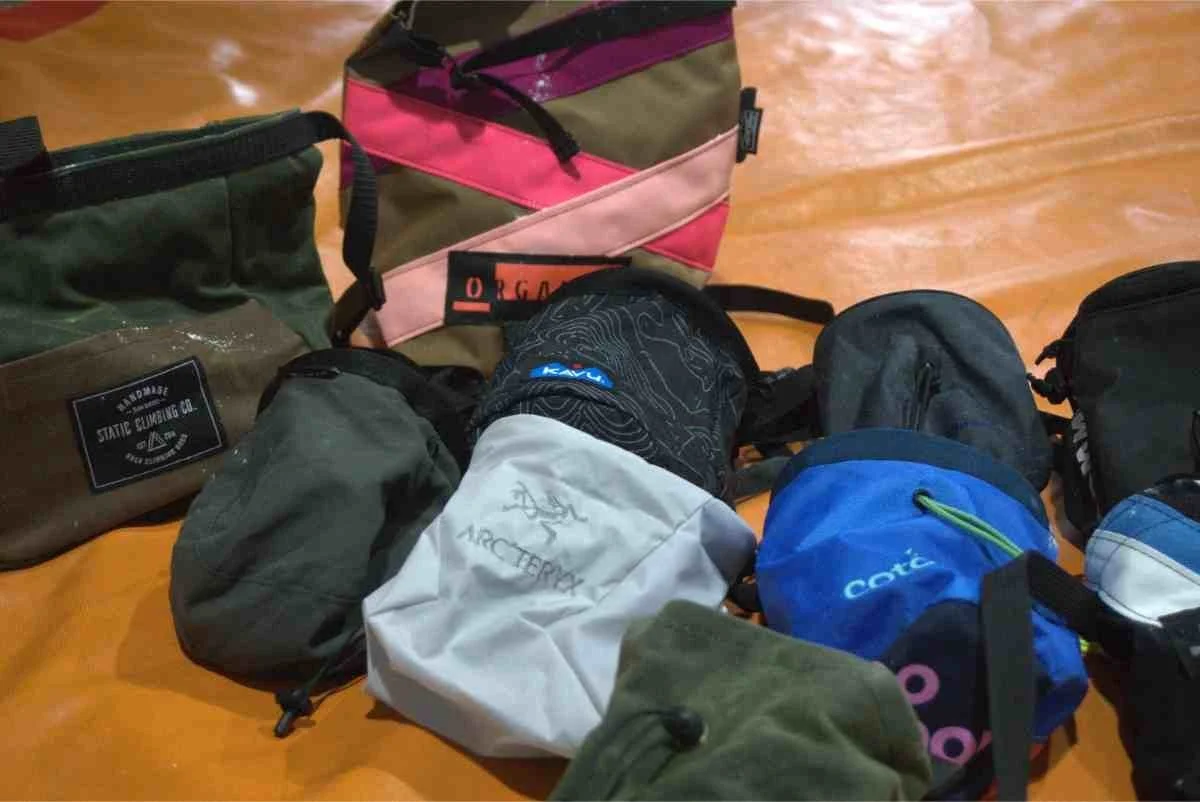Six Moon Designs Skyscape Trekker Tent Review
Dual side entries, roomy interior, and 8-½' length make the Skyscape Trekker one of the best solo shelters (especially for taller hikers)
Two Six Moon Design Skyscape Trekker tents side by side in Hells Canyon, Oregon.
Updated February 19, 2024
Home > Gear Reviews > Backpacking
Our Verdict
The Six Moon Designs Skyscape Trekker is one of the most innovative single-person ultralight tents on the market and my favorite solo shelter. I have used the Skyscape Trekker tent for thousands of miles of backpacking, thru-hiking, and bikepacking over the last three years and plan to continue using it in the future as my primary solo shelter.
Six Moon Designs (SMD) is one of the pioneers in the ultralight gear industry. SMD’s Lunar Solo (our review here) has been one of the most popular single-person tents since its release in 2005. The Skyscape Trekker, introduced in 2011, is a significantly different shelter design. The diamond-shaped shelter has two doors and two vestibules. The Skyscape Trekker has a hybrid double-wall design with a large mesh interior, significantly reducing interior condensation.
The Skyscape Trekker is a large and roomy shelter. The top of the canopy is offset to create more headroom when sitting up. A short carbon crossbar at the top of the tent creates steeper angled sides for a roomy interior. Although the Skyscape has less interior square footage than the Lunar Solo (23 vs. 26 square feet), the Skyscape feels roomier to me. The tent's interior is 8 1/2’ long, allowing tall hikers to stretch out fully without touching the sides of the tent. The canopy is 45” tall. There is plenty of room inside the Skyscape Trekker to sit up, change your clothes, and organize gear.
The Skyscape Trekker is very stormworthy. I have used the ultralight shelter in sustained 40 mph winds with higher gusts on the Pacific Crest Trail outside of Tehachapi and heavy rains in the mountains of New Mexico. The shelter’s bathtub floor forms perfectly with every pitch (no sagging corners).
My favorite feature of the Skyscape Trekker is the two large mesh doors on either side of the tent. The bug-proof mesh interior is spacious. The vestibule doors can be fully rolled up in good weather, creating a 300-degree view, giving me the feel of cowboy camping with protection from mosquitoes. In this gear review, we dive into why we think this ultralight tent should be on your list as a backpacking tent and bikepacking tent.
Six Moon Designs Skyscape Trekker
We create reader-supported, objective gear reviews independently selected by our editors. This story may contain affiliate links, which help fund our website. When you click on the links to purchase gear, we may get a commission – without costing you an extra cent. Thank you for supporting our work and mission of outdoor coverage for every body! Learn more.
Six Moon Designs Skyscape Trekker Specifications
Weight (excluding stakes): 28 ounces (790 grams)
Type: Hybrid double wall
Stakes required: 5
Pole required: 2 trekking poles or 2 45" carbon fiber or aluminum poles (sold separately)
Freestanding: No
Entry: Dual side entry
Floor area: 23 square feet
Vestibule area: 16 square feet (8 square feet per side)
Peak height: 45"
Packed size: 15" x 5"
Best For
The SMD Skyscape Trekker is a one-person backpacking shelter, designed for three-season use. It’s lightweight and durable enough for a long-distance thru-hike, and roomy and comfortable enough for weekend backpacking trips. The large interior space makes it an especially good choice for taller folks and hikers who like storing their backpacking gear inside the shelter.
The Skyscape Trekker is also an excellent bikepacking shelter. SMD sells 5-section carbon fiber poles or aluminum poles that will easily fit with your bikepacking kit.
How We Tested
I used the Skyscape Trekker as my primary solo shelter for several years. I carried the Skyscape Trekker thru-hikes of the Pacific Crest Trail, Mogollon Rim Trail, and Northern New Mexico loop. I have also carried the shelter on a number of bikepacking trips in the Pacific Northwest.
What We Liked
Plenty of usable interior space
Large, usable 8 sq ft vestibule
Hybrid double wall design
Storm worthiness
Side entry and oversized screen door
Good ventilation
Easy to pitch
Durability
Fabric
Usable Interior Space
The Skyscape Trekker is a very roomy solo tent. It is 8½’ long and 4’ wide. The canopy crossbar creates steeper walls and a wide ceiling that gives a more open feeling than other solo shelters. The interior height is 45”. There is plenty of room for a large person to sit up, change clothes, and organize gear without touching the interior walls. The extra long floor accommodates taller people and reduces the chance that the footbox of your sleeping bag will get condensation on it.
Double Doors and Vestibules
The Skyscape Trekker has two doors and vestibules. Its dual entry allows you to enter/exit and store gear on either side of the shelter. In good weather, the double vestibule doors can be completely rolled up to provide 300-degree views from inside the tent.
Hybrid double wall design
The Skyscape Trekker has large mesh sides creating a hybrid double wall construction, giving the benefits of a tarp and a tent. The only single-walled tarp portion is part of the canopy that extends from the apex to the toe. The massive side entrances with large mesh doors provide excellent ventilation, reducing condensation.
The Skyscape Trekker in Hells Canyon, Oregon.
Storm worthiness
I have used the Skyscape Trekker in high winds, rain, and snow. It has performed great in extreme conditions. The 8 ½’ length of the shelter helps to keep the sleeping bag/quilt toe box dry when there is rain. This is a problem I’ve had with most other shelters, including two-person shelters. The bathtub floor effectively keeps water out of the shelter. This proved useful during my southbound Pacific Crest Trail thru-hike where I experienced an early snow storm in the Sierra.
Protips:
In high wind, we recommend that the Skyscape Trekker be pitched so that the head faces the wind.
Be sure to seam seal your shelter. Six Moon Designs will provide seam sealing for $35 but this is only available when you purchase directly from the retailer. Under the Add to Carton button, check the box for seam sealing service.
Easy to pitch
The Skyscape Trekker can be set up in minutes (with a little practice). Only five stakes are required. The double doors on either side of the shelter have the benefit of allowing the tent to be set up in “tight” locations. The adjustable tension cords make it easy to get a taut pitch.
Durability
I have used the Skyscape Trekker for thousands of miles without any issues. The silicone-coated polyester floor (40D) and canopy (20D) is durable. This is the same revolutionary tent fabric used in the SMD Lunar Solo. I accidentally punctured the canopy when setting up the tent in high winds. The hole was easily repaired with Tenacious Tape. I have never torn the shelter floor despite never using a ground sheet. The #3 YKK zippers still perform well after thousands of miles–including desert hiking–and do not stick.
Pro tips: If you do get a tear or puncture, we recommend silnylon patches from Gear-Aid.
We strongly recommend regularly cleaning and treating your zipper with a zipper lubricant.
Fabric
SMD converted from silnylon to silpoly in 2019. We especially like that silpoly is more compressible and sags less than silpoly while maintaining the durability, lightweight, and waterproof qualities of silnylon. The result is a fabric that doesn't have the microsplash found in other fabrics during heavy rain. However, like all waterproof fabrics, you still need to seam seal this tent with a liquid seam sealer.
What Could Be Better
Larger, more internal pockets. The Skyscape Trekker has a small mesh cargo pocket. We would love additional and larger pockets to more conveniently store items in the shelter.
Larger Vestibule. I love that the Skyscape Trekker has two vestibules. The vestibules are large enough to provide protected storage for footwear and small pieces of gear. Unfortunately, the vestibules are not big enough to cook in when the doors are zipped closed. (Note: check with the manufacturer of your backpacking stove for best practices and safety recommendations for cooking while in a tent).
Features
Material
Six Moon Designs was one of the first tent manufacturers to convert from silnylon to a 100% silicone-coated polyester material (silpoly). The Skyscape Trekker has been manufactured with silpoly since 2019. The Silpoly used by SMD has a hydrostatic head of 3,000 mm, meaning that the fabric can withstand a 3-meter column of water; 1,400 mm is the minimum to be considered waterproof. We recommend tents be a minimum of 2,000 mm.
Silpoly is more compressible than silnylon. It is also less likely to sag, allowing for a tauter pitch. Siliconized polyester is less likely to trap moisture and is less likely to delaminate. Silpoly is shaking up the ultralight world, and as a smaller brand, Six Moon Designs has had the most time of almost any brand to perfect using it in a shelter.
Netting
SMD shelters have a no-see-um netting to protect against bugs. I have found the netting to be durable. However, I always carry a no-see-um patch kit on long trips.
Vestibule
The Skyscape Trekker has two (8 sq. ft.) vestibules on either side of the shelter. Vestibules are big enough for footwear or small pieces of gear. In good conditions, the vestibule can be completely rolled up, allowing surrounding views and improved ventilation.
Dual Side Entries
The Skyscape Trekker has large entries on both sides of the tent that are easy to enter and exit. I find using it much more comfortable and convenient than a front-entry shelter.
Floor Area
The Skyscape Trekker is a large single-person shelter. The top of the canopy is offset to create more headroom. A short carbon crossbar at the top of the tent creates steeper angled sides for a roomy interior. As a result, the Skyscape Trekker feels roomier than larger shelters. The tent's interior is 8 1/2’ long, allowing tall hikers to stretch out fully without touching the sides of the tent. The canopy is 45” tall.
Bathtub Floor / Floating Floor
The Skyscape Trekker has a very well-designed floating bathtub floor. I have found that the bathtub floor pitches perfectly every time. The floor “floats,” reducing stress on the materials and minimizing punctures. I have never had a puncture despite not using a ground sheet. SMD sells a lightweight polypro groundsheet for those who want extra protection.
Peak Height
The Skyscape Trekker has 45” of headroom inside the shelter. The carbon crossbar at the top of the canopy creates steeper walls creating more usable space inside the shelter. There is plenty of height to comfortably sit up and change clothes without touching the canopy.
Center Pole Support
The Skyscape Trekker uses two poles for setting up. The dual pole structure maximizes headroom with a single center pole support that is offset. You can either use two trekking poles, set at 45” or SMD sells carbon poles or aluminum poles. They have 5-section carbon and aluminum poles that fold smaller and fit perfectly in a bikepacking kit.
The center pole support provides great stability for wind or snow loads. The Skyscape Trekker is designed to shed wind from all directions; however, SMD recommends that in the windiest conditions, the shelter be pitched so that the head of the tent faces the wind.
Storage Pocket
The Skyscape Trekker has a single internal pocket. As we note in “What Could Be Better” we would like to see larger, additional pockets inside the shelter.
The Lunar Solo on the author’s southbound Pacific Crest Trail thru hike.
Lunar Solo Vs. Skyscape Trekker
Six Moon Design (SMD) is a pioneer and innovator in the ultralight backpacking industry. The Lunar Solo has been one of the most popular ultralight shelters since its introduction in 2005. SMD introduced the Skyscape Trekker in 2011. There are many similarities between the Lunar Solo and Skyscape Trekker.
Both are large, lightweight, side-entry, one-person shelters that are easy to pitch and stormworthy. But there are some significant design differences. The Lunar Solo is a more polygon shape using one pole with one large door and vestibule. The Skyscape Trekker is diamond-shaped, using two poles with two doors and vestibules.
Here is a breakdown of the Lunar Solo and Skyscape Trekker:
| Lunar Solo | Skyscape | |
|---|---|---|
| Cost | $260 | $275 |
| Design | Polygon-Shaped | Diamond-Shaped |
| Weight | 26 ounces | 28 ounces |
| Doors | 1 | 2 |
| Poles Required | 1 | 2 |
Lunar Solar Advantages
The vestibule is larger, adjustable, and more usable.
Only one pole is required.
Packs smaller (11” x 4.5” vs. 15” x 5”)
Lighter (26 vs. 28 ounces)
Less expensive ($260 vs. $275)
More interior space (26 vs. 23 sq. ft.). But it feels smaller than the Skyscape. (This is due to the Skyscape’s crossbar that steepens the wall angle from the canopy to the floor.)
Skyscape Trekker Advantages
Dual doors and vestibules
Doors on both sides can be fully rolled up, providing 300-degree views
Hybrid double-wall design reduces condensation
8½’ length provides plenty of space for taller hikers to stretch out
Off-set poles and canopy crossbar provides a very roomy interior. The Skyscape Trekker feels more spacious than the larger Lunar Solo.
Only 5 stakes are required.
Both the Lunar Solo and Skyscape Trekker are great shelters. So which is right for you? I prefer the Skyscape Trekker because the extra length allows me (at 6’ 1”) to stretch out without touching the head or foot of the shelter. The steeper walls and canopy crossbar makes the shelter feel roomier. I can change clothes, pack, and do errands inside the Skyscape without touching the walls.
Where to buy
The Six Moon Designs Skyscape Trekker are popular gear items, so you have options when it comes to retailers. Here are some of the pros of the retailers.
Amazon
Pros: Free 2-day shipping with Amazon Prime membership
Garage Grown Gear
Six Moon Designs
You can sometimes find more options when purchasing directly from the retailer. Sometimes, purchasing directly from the retailer can make it easier if you need to make a warranty return, such as if there is a defect.
Other Versions Available
Skyscape Scout
Weight (excluding stakes): 40 ounces (1136 g)
Type: Hybrid double wall
Stakes required: 5
Pole required: 2 trekking poles or 2 45" carbon fiber or aluminum poles (sold separately)
Freestanding: No
Entry: Dual side entry
Floor area: 23 square feet
Vestibule area: 16 square feet (8 square feet per side)
Peak height: 45"
Packed size: 15" x 5"
The Skyscape Scout is modeled after the Skyscape Trekker but uses a more cost-effective (and heavier) 190T polyester fabric. The Skyscape Scout weighs 40 ounces and costs $160.
COMPARE PRICES OF THE SKYSCAPE SCOUT
Other Tents to Consider
Six Moon Designs Lunar Solo
The Skyscape Trekker is a 1-person shelter with a single large door and vestibule. The Lunar Solo has a weight of 26 ounces and costs $260. You can see our full review of this shelter here.
I also have thousands of miles with the Lunar Solo, and it’s one of SMD’s best-selling tents for a reason.
COMPARE PRICES OF THE SIX MOON DESIGNS LUNAR SOLO
Nemo Hornet OSMO
Weight: 36 ounces (includes stakes)
Type: Single wall tent
Pole required: poles included
Freestanding: Semi-freestanding
Entry: Side entry
Floor space: 22.3 ft2 - 2.2 m2
Vestibule area: 7.3 ft2 - 1.4 m2
The Nemo Hornet OSMO is a 1-person double wall shelter. The Hornet is semi-freestanding (no trekking pole necessary) with a single door and vestibule. The Hornet weighs 29 ounces and costs $400. You can still find the previous version, called the Nemo Hornet (no Osmo) made of a 10D Sil/PeU Nylon Ripstop for $269. A lightweight version, the Hornet Elite Osmo, weighs 29 oz and retails for $550.
You can read more about the Nemo Hornet Osmo Elite in our in-depth review.
COMPARE PRICES OF THE NEMO HORNET OSMO
HORNET
HORNET ELITE
Tarptent Notch
Weight: 28.0 ounces (includes stakes)
Type: Single wall tent
Pole required: 2x trekking poles (42-45") or 2x Tarptent's vertical poles for bikepackers and bike touring
Freestanding: Semi-freestanding
Entry: Dual side entry
Floor space: 15.75 ft2 - 2.2 m2
Vestibule area: 16 ft2 - 1.4 m2
The Tarptent Notch is a double-walled, double door and vestibule 1-person shelter. It requires two trekking poles to pitch. The Notch weighs 28.0 ounces (including stakes) and costs $259 (for the mesh interior).
COMPARE PRICES OF THE TARPTENT NOTCH
Gossamer Gear The One
Weight (excluding stakes): 17.7 ounces
Type: Single wall tent
Pole required: 2x trekking poles (set to 125 cm) or 2x Gossamer Gear's vertical poles for bikepackers and bike touring
Freestanding: Semi-freestanding
Entry: Dual side entry
Floor space: 19.5 SF ft2
Vestibule area: 10 ft2
The Gossamer Gear The One is a single-walled 3-season shelter with two doors and vestibules. The new weight is 17.7 ounces and costs $255. It's made of a 10D Nylon Ripstop SIL/PU fabric.
When we tested The One, we noticed a fair amount of condensation in the morning. We were surprised, as we slept with both doors open. Our testing of The One is currently ongoing.
COMPARE PRICES OF THE GOSSAMER GEAR THE ONE
About the Author / Why You Should Trust Us
Mike Unger has been thru-hiking since 2006. He’s closing in on 28,000 miles on North American long trails and is one of a handful of people who is a Double Triple Crowner, having hiked the Appalachian Trail, Pacific Crest Trail, and Continental Divide Trail each twice. He’s also hiked more obscure routes like the Pacific Northwest Trail, Ouachita Trail, Oregon Desert Trail, Grand Enchantment Trail, and was part of the group that set the First Known Time on the Blue Mountains Trail.
He’s also picked up another passion along the way: long-distance bicycle touring, including the 1,850 mile Pacific Coast route. When he’s not hiking or biking, he’s probably planning his next trip and/or researching gear.
You can read all articles by Mike Unger here.

